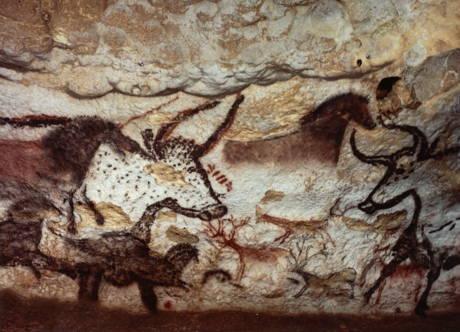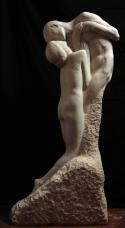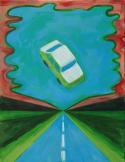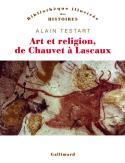Art Of The Day Weekly
#453 - from 15 December 2016 to 21 December 2016

© Atelier des Fac-Similés du Périgord.
IN THE AIR
Lascaux, 21st century version
MONTIGNAC - In 1940, some youths from the village of Montignac, in the Périgord region, followed their dog into a cave and made one of the major archaeological discoveries of the 20th century: the grotto of Lascaux. In 1963, the grotto was closed to the public to avoid further damage caused by record levels of visitors. Since the 80s, those frustrated from not seeing Lascaux have been able to see replicas of the 20 000 year old paintings: Lascaux 2, the pioneer copy from 1983, and then Lascaux 3, that has been travelling the world since 2012. On 15 December, Lascaux 4, the most complete reproduction, will be opened at the foot of the original hill, in a building in the shape of the blade of a knife, designed by Norwegian architects Snohetta. It houses almost all the grotto, in a rather confounding “reality”, developed with the most advanced methods. But it intends to be more than a mere copy as its’ name spells out: Centre international de l’art parietal (International Centre for Cave Art). The public can follow an introduction to the art of grottos (of which the first great discovery was in 1878 with the discovery of Altamira), understand the techniques and measure the impact of these figures, considered by most specialists as a big joke until 1900, since they believed the pre-historic man was incapable of any artistic expression. That influence went all the way to the art of the 20th century, from Picasso to Gasiorowski.
• Lascaux 4, Centre international de l'art pariétal, will open to the public on 15 December 2016
EXHIBITIONS
Prini, under the sign of Rodin
ROME – It is quite brave today to set up an exhibition of a sculptor if the name is not Rodin, or Maillol or Bourdelle. Giovanni Prini (1877-1958), presented at the Galleria d’arte moderna, is ill known in his own country and absolutely unknown abroad. Yet he is part of a golden age of Italian art, a contemporary and friend of Sironi, Cambellotti, Boccioni, Severini, all regular guests at his home on Via Nomentana, and who played a part in the movements that linked Symbolism, Art nouveau and Futurism. Prini delved into biblical and patriotic themes, such as the statue of Victory or death masks, as well as portraits of friends and loved ones, like that of Lilli, Giacomo Balla’s daughter. His great work Lovers from 1913, often reproduced, clearly shows the influence of Rodin’s Kiss. He was a surprising individual who was criticized for flirting with the government of a certain period by creating statues to the glory of Fascism and gave lessons to queen Elena. But he also directed the SFAGI toy factory in the period between the two wars. His funny birilli -pawns for the Italian billiards – were shown during the exhibition on “The Child of the Century” at the MoMA in 2013.
• Giovanni Prini, il potere del sentimento at the Galleria d’arte moderna, from 21 December 2016 to 26 March 2017.
To translate well, for the love of languages
MARSEILLE – Where has the capacity of speaking various languages gone? This exhibition brings together objects that span various centuries, from a diplomatic letter in cuneiform writing to the movie Film Socialisme, by Jean-Luc Godard, sub-titled in “Navajo English”, and shows the challenges taken on by translation to share the wealth inherent to each language. But it also shows what cannot be translated. A society that translates less is in the long run a society that gets poorer. Today, among the 6,000 languages registered, many are threatened of disappearing (Claude Hagège believes one language dies every two weeks). Translation could be considered a mission of public interest!
• Après Babel, traduire at the Mucem, from 14 December 2016 to 20 March 2017.
THESE EXHIBITIONS ALSO OPEN THIS WEEK
Industrialist landscapes
MUNICH – Albert Renger-Patzsch (1897-1966) was a great photographer from the movement of New Objectivity. He dedicated an important documentary at the end of the 1920s to the Ruhr region. At the Pinakothek der Moderne, from 16 December 2016 to 23 April 2017.
Eternal sites
PARIS – This exhibition places the viewer in the monuments of four great cities of the Antiquity, just when we learn that Palmyra has once again fallen to the hands of the IS. At the Grand Palais, from 14 December 2016 to 9 January 2017.
Bombs at the museum
TORINO – The capital of Piemonte was bombed a number of time during World War II by the allies. The Galleria d’Arte moderna was hit on 20 November 1942 and would not reopen before 1959. This retrospective of 60 works of art and some 100 photographs from that time, studies the suffering and the rebirth of the museum and the city, in the museum itself. From 14 December 2016 to 14 May 2017.
Landscapes by Tina Blau
VIENNA - Tina Blau (1845-1916) was a great landscape artist of the 19th century. Her native town presents her through a series of major works. At the Belvedere, from 16 December 2016 to 9 April 2017.
ARTIST OF THE WEEK
Gillaume Pinard, a drawing right away
In an interview in 2009 with Thimotée Chaillou, he declared his opposition to “expensive productions, to monumental works, to ostentation.” His ideal was to prepare an exhibition with a simple handbag. Guillaume Pinard wishes to be considered as a drawer rather than an artist, claiming he works as an artisan, with an often quick, physical effort. He excels in charcoal drawings, often in big dimensions, of contemporary scenes or inspired from the Antiquity, in landscapes, drawings of interiors. But he was also capable of producing very small works. Guillaume Pinard wants his works to form installations. Consequently he hangs them following deep thoughts on their relation to the scale, to holes, to perspectives and alignments. In his more recent works, Pinard has worked with acrylic paint, producing a totally different matter, a sort of hybrid between Garouste, Brauner’s Surrealist visions and Magritte’s “peau de vache” period. Guillaume Pinard, whose work is exhibited at the galerie Anne Barrault, is one of the winners of the 2016 award from the Fondation Colas on the theme of the road.
OPENINGS OF THE WEEK

ERIC PILOT - IN SITU 2010-2016
17 December 2016 - SENS - Orangerie
A poetical look at the relations between man and animal
BOOKS
Lascaux, a lasting mystery
Since the grottos were discovered, the question has been almost permanent, “why did prehistoric men cover the walls of grottos for over 20,000 years?” Will it ever have a decisive answer? Is it due to a simple artistic taste, magical hunting rites, shamanic rituals with the beyond? From Chauvet (circa -37 000) to Lascaux (circa -18 000), hundreds of grottos were decorated with paintings, but also with engravings. Anthropologist Alain Testart describes in a posthumous work –he passed away in 2013- and in a systematic way the signs left by our ancestors: animal species, sexual symbols or geometric motives. He suggests we see those grottos as spaces clearly defined as being feminine, sorts of large uteruses, that would prove a sort of Totemic thinking and a sophisticated cosmogony. The idea is rather complex, like for example when he looks at the questions of symmetry, that aim to prove that grottos such as Lascaux were places seen in their global aspect. This position is mitigated by the regular rhythm given by the chapters and the great number of illustrations.
• Art et religion - de Chauvet à Lascaux, by Alain Testart, Gallimard, 376 p., €26.




